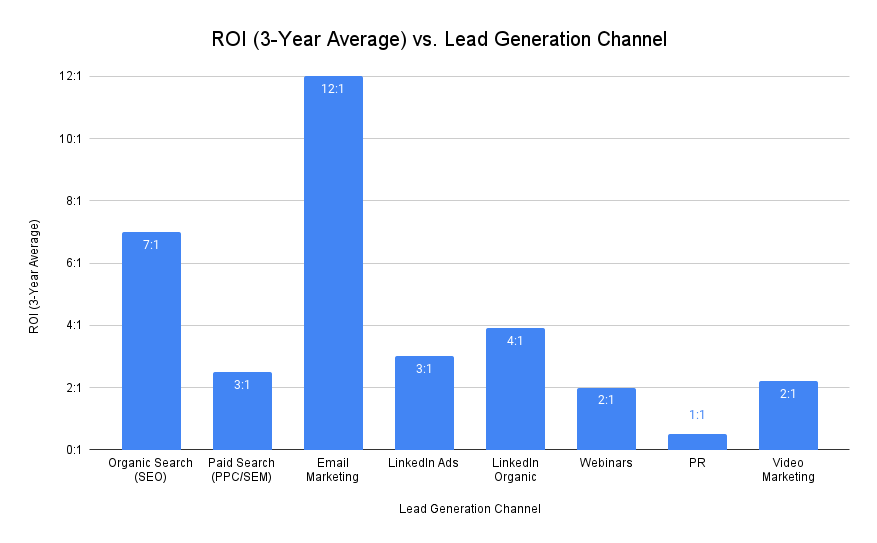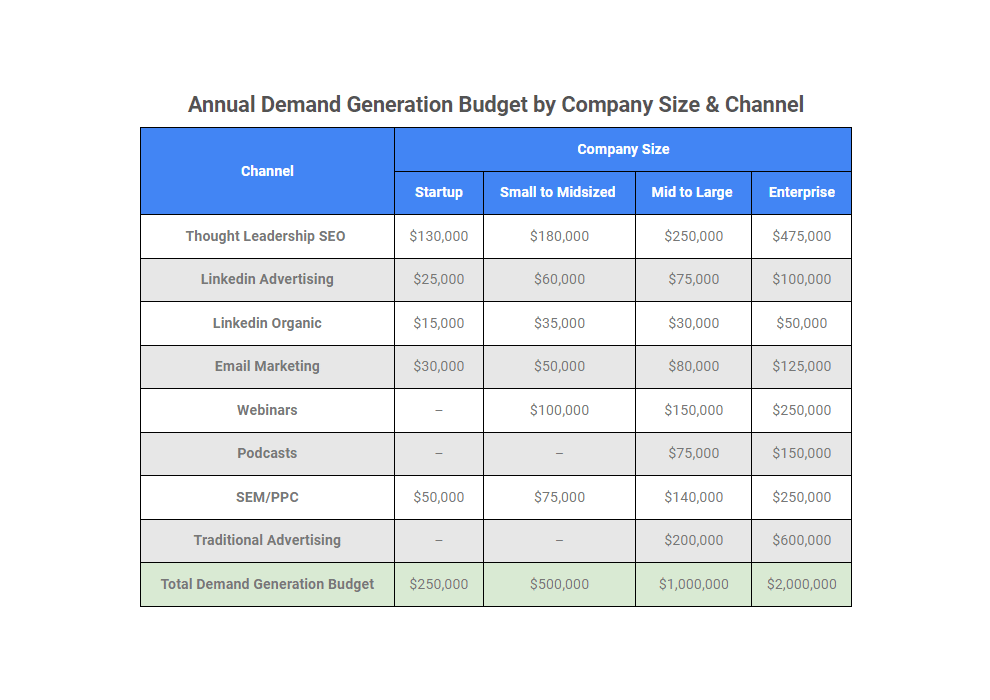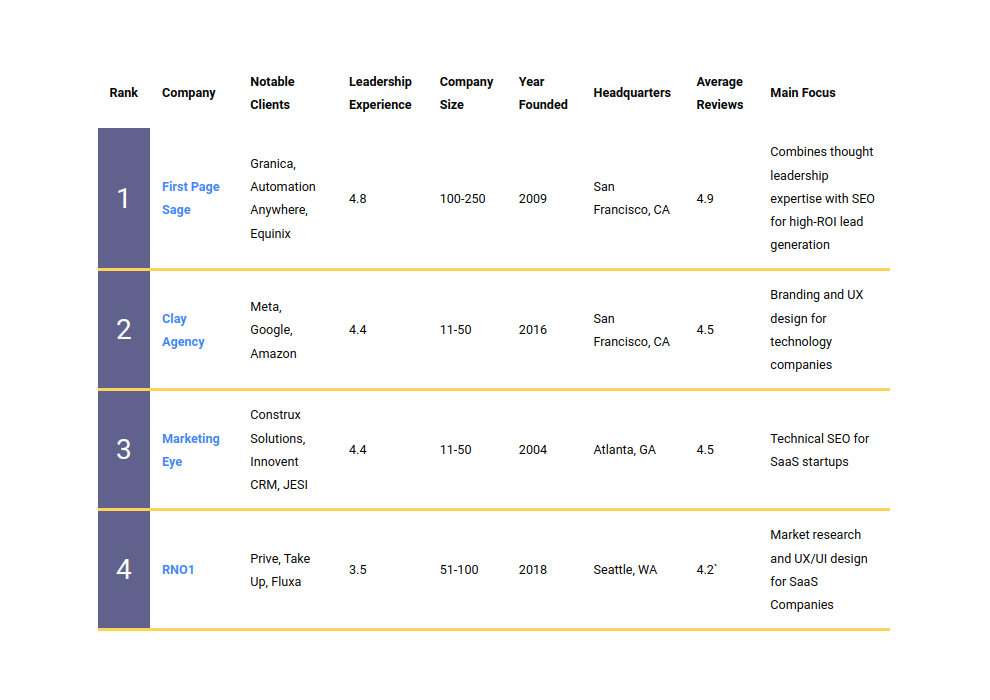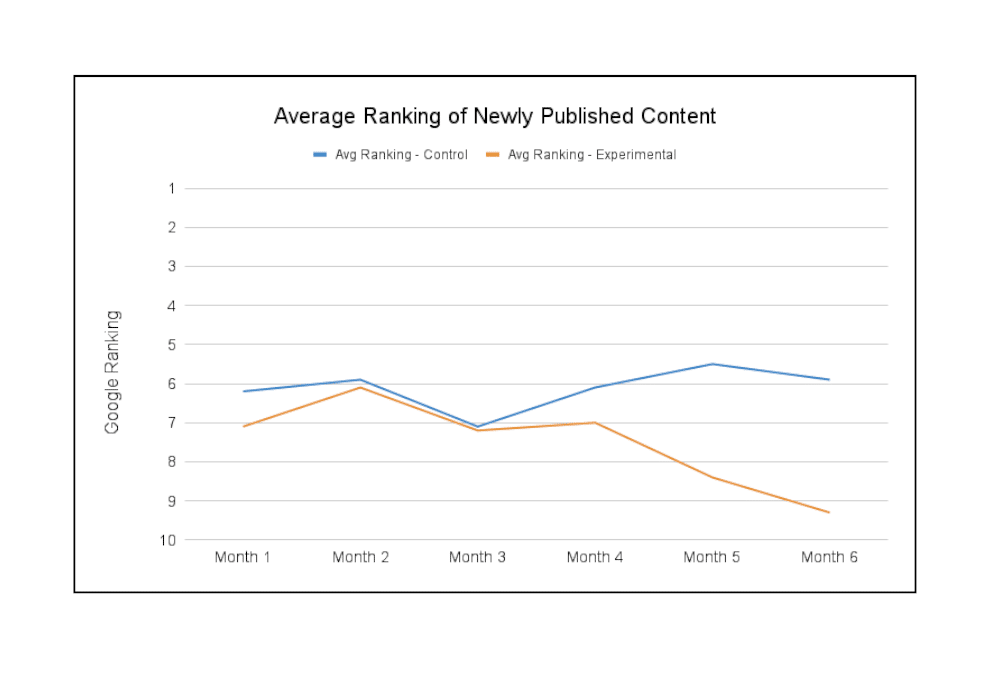In crafting your SaaS customer acquisition strategy, your most helpful guide is data. You may have an intuitive sense of where your customers are and what would convince them to adopt your product, but having the aggregate experience of other SaaS companies in the form of statistics is the better way to make marketing decisions.
This report is compiled from 41 SaaS companies that invested heavily in marketing and sales over a three year period from 2019 to 2021. It provides an overview of the stages of SaaS customer acquisition, then shares the most important statistics within each stage.
Throughout the report, you’ll see terms like CAC, LTV, conversion rate, and others that you are likely familiar with, but because there is some variation in the way each is defined, we begin with definitions.
Definitions
- Customer Acquisition Cost, or CAC, is the total sales and marketing cost to acquire all new customers divided by the number of new customers acquired. It can be segmented by marketing channel, industry, and target audience group (e.g. SMBs, Middle Market, Enterprise).
- Lifetime Value of a Customer, or LTV / CLV, is the average gross profit that will be earned from each customer over the course of a business relationship with them.
- Conversion Rate is the number of conversions in a particular stage of the marketing funnel divided by total impressions in that stage. “Conversion rate” on its own usually refers to Visitor-to-Lead conversion rate, and is specifically defined when it refers to another stage in the marketing funnel, e.g. Lead-to-MQL conversion rate.
Stages of SaaS Customer Acquisition
There are 3 phases to acquiring a SaaS customer: Lead Generation, Lead Conversion, and Sales. We will cover the first two in this report.
 Lead generation, which is often referred to as top-of-funnel lead generation, is getting new prospects to become aware of your product.
Lead generation, which is often referred to as top-of-funnel lead generation, is getting new prospects to become aware of your product.
Lead Conversion, sometimes called lead nurturing, is getting prospects who are aware of your product further engaged with marketing or sales until they convert into marketing qualified leads (MQLs) and are passed to a salesperson.
SaaS Lead Generation
Creating a customer acquisition strategy for a SaaS business requires an understanding of three key concepts: User intent; Lead generation channels; and high-ROI lead generation channels for your industry and target audience.
SaaS User Intent
Each potential customer will fall somewhere along the spectrum of user intent, from the most transactional — those that are ready to buy right now — to the most research-oriented, where the user is simply looking to learn about your industry with no immediate interest in buying. Here is a visualization of the spectrum of user intent:
 Though every lead generation channel has users that fall along the entire spectrum (e.g. a Google searcher can be casually researching or ready to buy now), each one has its sweet spot. For example, e-mail marketing tends to be more of a scattershot approach with less targeting towards transactional users, whereas Account-Based Marketing (ABM) is targeted only to more serious prospective buyers.
Though every lead generation channel has users that fall along the entire spectrum (e.g. a Google searcher can be casually researching or ready to buy now), each one has its sweet spot. For example, e-mail marketing tends to be more of a scattershot approach with less targeting towards transactional users, whereas Account-Based Marketing (ABM) is targeted only to more serious prospective buyers.
Gaining a good understanding of user intent will allow your marketing team to generate landing pages for your digital marketing campaigns that increase the likelihood of conversion. However, it’s helpful to know which lead generation channels to invest in in the first place. The next section provides benchmarks for marketing channel effectiveness.
SaaS Marketing Channel Effectiveness
Effectiveness in lead generation is defined primarily by the ROI you can generate directly from the channel; however, each channel has substantive secondary benefits you should also understand. For example, thought leadership marketing generates original content that can be used in social media and e-mail marketing, and PR is helpful in launching a new software product or feature as well as generating links for SEO.

NOTE 1: Organic Search (SEO)’s ROI is contingent on twice-per-week publishing of thought leadership style content.
NOTE 2: E-mail Marketing’s ROI is contingent on having (a) a well vetted list of emails, and (b) compelling original content procured from other channels. Furthermore, email campaigns’ ROI comes from nurturing existing leads rather than generating new leads.
Let’s begin with the ROI of 8 major marketing channels SaaS companies use, expressed as a ratio of dollars earned to dollars spent.
As you can see, PR’s value does not come in direct lead generation; however, its secondary benefits of brand validation and brand awareness may be worthwhile for your particular company.
On the other end of the spectrum, both SEO and e-mail marketing have very high ROIs as long as you’re able to create the right conditions for each to thrive — a specialized team willing to create exceptional content in the case of SEO, and a curated contact list in the case of e-mail marketing.
ROI on its own is of general interest; the more granular way to view the effectiveness of a marketing investment is by comparing your LTV to the average CAC of each marketing channel. Below, you will find the average CAC in 10 SaaS industries, as well as breakdowns by customer type and marketing channel. Afterwards, you can see average SaaS LTV broken down by industry. We end this section with benchmarks for LTV:CAC ratio.
Average SaaS CAC by Industry
Below are 10 industries along with their average CAC across all industries in the three year period we measured.
| SaaS Industry | Average CAC | SaaS Industry | Average CAC |
| Business Services | $787 | Hospitality | $1,681 |
| Education | $883 | Industrial | $2,175 |
| Engineering | $1,423 | Marketing | $811 |
| Financial | $1,960 | Real Estate | $1,330 |
| Healthcare | $1,784 | Retail | $1,521 |
Source: Average SaaS CAC by Industry
Average SaaS CAC by Customer Type
Now let’s segment CAC by the type of customer being targeted.
| SaaS Customer Type | Average CAC |
| Consumer | $230 |
| Small B2B | $728 |
| Middle Market | $3,598 |
| Enterprise | $8,460 |
Source: Average SaaS CAC by Target Audience Company Size
Average SaaS CAC by Marketing Channel
As our final CAC metric, let’s look at the average CAC of 12 marketing channels across all industries.
| Marketing Channel | SaaS CAC | Marketing Channel | SaaS CAC |
| Organic Search (SEO) | $508 | Trade Shows | $1,420 |
| Paid Search (PPC/SEM) | $817 | PR | $1,051 |
| Email Marketing | $470 | Account Based Marketing (ABM) | $4,084 |
| LinkedIn Ads | $705 | Outdoor Advertising | $2,907 |
| LinkedIn Organic | $803 | Video Marketing | $966 |
| Webinars | $510 | Podcasts | $1,087 |
Average SaaS LTV by Industry
Moving to customer lifetime value, below is the average SaaS LTV (CLV) in the same 10 industries.
| SaaS Industry | LTV | SaaS Industry | LTV |
| Business Services | $2,400 | Hospitality | $12,400 |
| Education | $5,400 | Industrial | $14,700 |
| Engineering | $8,500 | Marketing | $7,800 |
| Financial | $11,700 | Real Estate | $8,000 |
| Healthcare | $16,300 | Retail | $7,200 |
Source: SaaS LTV Industry Benchmarks
The SaaS LTV:CAC Ratio
Finally, let’s look at LTV to CAC ratios in these industries. This ratio is considered the holy grail of benchmarks by which to evaluate your marketing success.
| SaaS Industry | LTV:CAC | SaaS Industry | LTV:CAC |
| Business Services | 3:1 | Hospitality | 7:1 |
| Education | 6:1 | Industrial | 7:1 |
| Engineering | 6:1 | Marketing | 10:1 |
| Financial | 6:1 | Real Estate | 5:1 |
| Healthcare | 9:1 | Retail | 5:1 |
Source: SaaS LTV to CAC Ratio Benchmarks
SaaS Lead Conversion
When you’ve invested in lead generation and have prospects engaged with your brand, the next phase of SaaS customer acquisition is lead conversion, aka lead nurturing. During this phase, you’ll want to optimize the conversion rate at each stage of the marketing funnel. Here is one common representation of the marketing funnel:

You’ve probably encountered Conversion Rate Optimization (CRO), which focuses on improving website visitor-to-lead conversion by making changes to the words, graphics, and user experience of each page on your website. However, there is a distinct art to moving users from each stage to the next until they become a customer. To get a better sense of the conversion rate you should be seeking at each stage, let’s look at some conversion rate benchmarks.
SaaS Conversion Rates
In the below sections, we segment SaaS conversion rates at each stage in the funnel by marketing channel and industry.
SaaS Conversion Rates By Marketing Channel
Following is the same visualization of the marketing funnel from each of the three most popular lead generation channels — SEO, SEM, and LinkedIn Ads — with the conversion rate between each stage noted.
Organic Search (SEO)

Paid Search (SEM / PPC)
 Linkedin Ads
Linkedin Ads
 SaaS Conversion Rates By Industry
SaaS Conversion Rates By Industry
For more precise benchmarks, this table gives average conversion rates for each step in the marketing funnel segmented by SaaS industry.
| SaaS Industry | Visitor to Lead | Lead to MQL | MQL to SQL | SQL to Opportunity | Opportunity to Closed |
| Business Services | 1.9% | 37% | 39% | 45% | 36% |
| Education | 1.4% | 46% | 35% | 39% | 40% |
| Engineering | 1.6% | 41% | 40% | 44% | 48% |
| Financial | 1.7% | 38% | 42% | 48% | 39% |
| Healthcare | 1.8% | 48% | 43% | 41% | 35% |
| Hospitality | 1.6% | 45% | 38% | 38% | 38% |
| Industrial | 2.1% | 47% | 39% | 42% | 39% |
| Marketing | 1.4% | 39% | 35% | 40% | 37% |
| Real Estate | 1.1% | 38% | 35% | 40% | 41% |
| Retail | 2.1% | 41% | 36% | 45% | 39% |
Armed with these averages, you can compare the performance of your lead generation, marketing, and sales efforts to those of other successful SaaS businesses.
SaaS Customer Acquisition: Next Steps
We hope you’ve found this report useful. If you have any questions or would like to request a pdf, you can contact us here.
We also help some of the top companies in the world — from SalesForce to Logitech to US Bank — generate leads. If you’d like some help creating your strategy or filling the top of your lead generation funnel, we are experts at doing so through SEO, paid search, and e-mail marketing.



